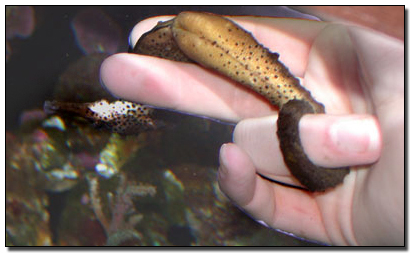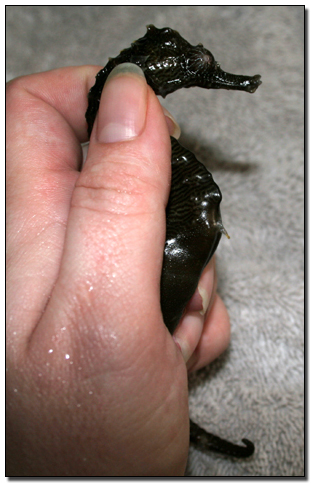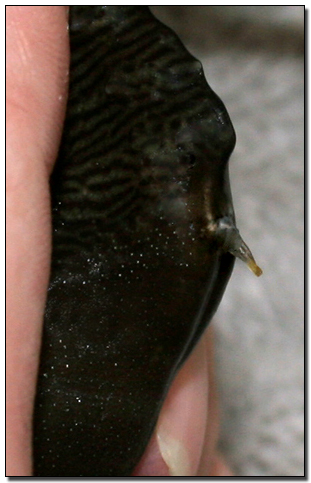Evacuating the brood pouch
of a male seahorse may be necessary from time to time if a
male's pouch accumulates excessive gas in the pouch. At first,
this may seem like a frightening thought, but its really very
simple to do, even with the squirmiest of guys. Just remember,
seahorses are smart and he'll probably sulk and shy away for
a few days. That's okay.
Equipment you'll need
- shallow container with tank water
- blunt tipped bobby pin, soft plastic pipette, or iv catheter
sleeve with needle removed
- moral support
First, you'll need to grasp the male firmly underwater. Some
people prefer to do this in a shallow container with tank
water, but once you're proficient at it, you can do this in
the tank. If you do it in a separate container, make sure
there is enough water to fully cover the seahorse from back
to tip of snout with your hand holding him. He shouldn't be
exposed to air during the procedure.
To hold the male, position him so he is laying across the
palm of your hand. I prefer having it so the male's upper
body rests between my index and middle fingers, as it aids
in manipulating the pouch. You'll want to get him to wrap
his tail around your pinky or ring finger or he'll use it
to grab his head, snout, etc. to block you from getting to
his pouch. He may struggle for a bit, but keep him immobilized
without squeezing too tight, and he'll calm down. Eventually.
Some males take longer than others to relax.
 Once he's still, you'll want to begin applying pressure to
his pouch. First try without using any tools to open the pouch.
You'll want to apply pressure from the front at the base of
the pouch and work your way up. Do this in sort of a rolling
fashion, keeping the area you previously applied pressure
to down and working your way up. Sort of like a tube toothpaste.
Its hard to describe the exact pressure needed, its not too
hard but not too gently either. Do what feels comfortable
to you, and remember, you can always try again if you don't
apply enough pressure the first time you do it. One common
mistake is the use of rubbing as the term "pouch massage"
is often used to describe thus procedure. The pouch is soft
skin so intensive rubbing can lead to skin damage and infection.
Instead, you want to apply pressure in a more direct pushing
fashion. You may also need to gently squeeze the sides of
the pouch to direct the air towards the opening, using the
free hand to squeeze while using you holding hands thumb to
push.
If all goes well, the bubbles will start to come out of the
pouch opening. This is why I prefer doing the procedure in
tank; you can tip Mr. seahorse so his pouch opening is the
highest point, thus allowing the air to leave.
If it does not come out on its own, you may need to tease
the pouch open. This is where it gets tricky, especially if
you do it alone. But, as I can attest, it can be done on your
own with patience and dedication. However, if you can find
a non-squeemish friend to help the first few times, it might
be a good idea.
Note that the pouch opening in located immediately below the anal fin. Above is the anus where you don't want to be inserting a catheter. Find the fin before proceding.
 
Again, hold the seahorse the same way in your palm. Now you'll
need to force the air near the opening of the pouch similar
to before to make the pouch opening more taut. You can do
this with the thumb of your holding hand. Now, hold the insertion
tool, (blunt bobby pin, pipette, or catheter) between your
thumb and index finger of the free hand and work at pushing
the sides of the opening away. He will be holding it tight,
so it may take a little while of gently working at it to get
him to relax enough to let it open. You may not be able to
see the opening as the pouch folds around itself here. Keep
working gentle, careful to not actually insert into the pouch
while doing this procedure. You will know when its open when
the stream of bubbles comes out. Hold open and with the fingers
you're putting pressure on the pouch with, keep working your
way up until the air is all out.
In a small number of males, even teasing the pouch open will
not work to get the air out. In those cases, you will have
to use an iv catheter sleeve to insert completely into the
pouch to release the air. Follow the above procedure to enter
the pouch, and then slide in at an angle so the catheter is
parallel to the body/tail. It may require gently wiggling
in all areas inside the pouch to find the bubble. I have done
this on a couple of my males, and while it has not noticeably
caused problems, neither have bred since than so its not known
whether or not this causes complications with infertility.
It seems unlikely but it is something to keep in mind before
attempting.
Hopefully this will displace the air and your male seahorse will go on to enjoy many pregnancies.
|
